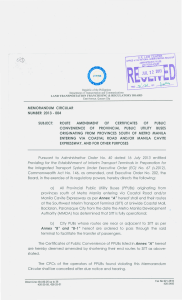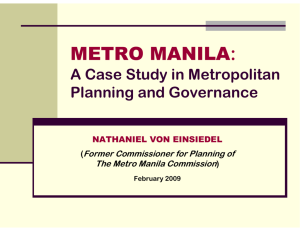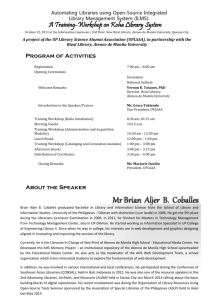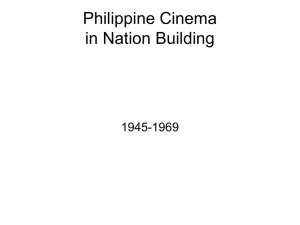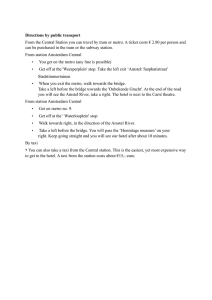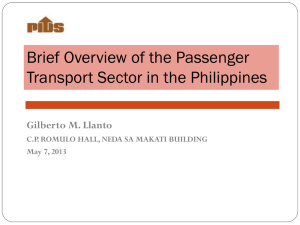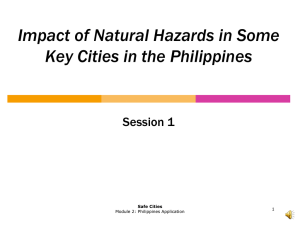Assessing the Impacts of Traffic Mitigation Measures in
advertisement
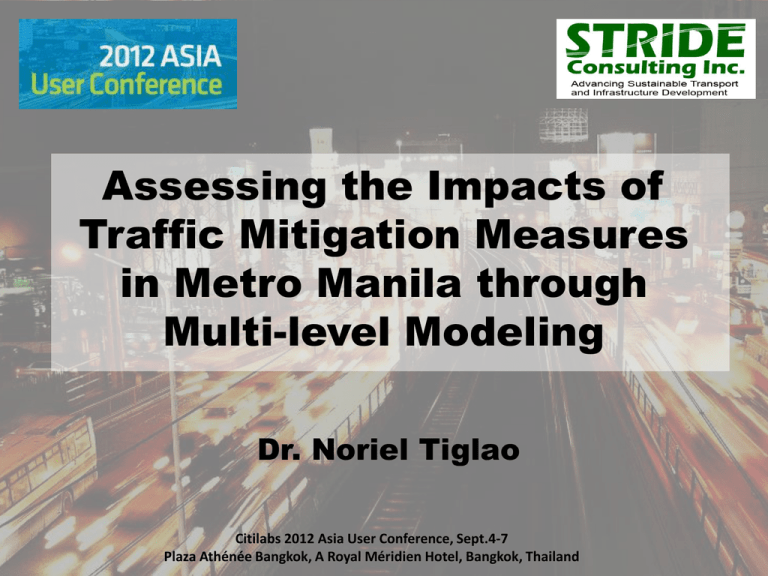
Assessing the Impacts of Traffic Mitigation Measures in Metro Manila through Multi-level Modeling Dr. Noriel Tiglao Citilabs 2012 Asia User Conference, Sept.4-7 Plaza Athénée Bangkok, A Royal Méridien Hotel, Bangkok, Thailand Outline • • • • • • Metro Manila Urbanization Travel Demand Patterns Nature of Traffic Congestion Problem Transport Modelling Issues Need for Multi-level Modelling Benefits of Cube 2 Metro Manila Urbanization • High population growth rates and in-migration • 13 percent of the country’s population are packed in only about 0.2 percent of the country’s land area • Metro Manila dominates the economy accounting for 43.5 percent of the country’s GDP in 2000 • The effect of rapid urbanization of the metropolis spilled over the adjoining municipalities • Comprised of 17 cities and municipalities 3 Metro Manila Land Area: 636 sq. km Population (2007): 11.55 million Population Density (2007): 18,166 persons/ sq. km 4 ‘Mega’ Manila 100-Km radius Land Area: 38,544 sq. km Population (2000): 27.4 million Population Density (2000): 712 persons/ sq. km 5 Metro Manila Traffic Demand Priva te Se m i Pu b lic Pu b lic M od e M oto rc yc le 1/ C a r/Jee p + U V T ru c k S u bto tal Taxi H O V Taxi P riv a te B u s S u bto tal T ric yc le Jee p ne y B us LR T PNR S u bto tal T ota l Person T rip s N o . (0 0 0 ) (% ) 1 25 0 .7 3 ,2 89 1 8.5 4 22 2 .4 3 ,8 36 2 1.6 8 62 4 .9 2 26 1 .3 4 40 2 .5 1 ,5 28 8 .6 2 ,3 73 6 ,9 52 2 ,6 53 4 09 6 1 2 ,394 1 7 ,758 1 3.4 3 9.1 1 4.9 2 .3 0 .0 6 9.8 1 0 0 .0 A v era g e O c c u pa n c y 1 .1 2 .5 2 .1 2 .2 4 .7 2 2.3 2 .5 1 5.1 4 6.5 - N o. (0 00 ) 111 1 ,3 3 0 203 1 ,6 4 3 396 48 20 464 938 461 57 1 ,4 5 6 3 ,5 6 4 V e hic le T rip s (% V eh ic le) 3 .1 3 7.3 5 .7 4 6.1 1 1.1 1 .4 0 .6 1 3.0 2 6.3 1 2.9 1 .6 4 0.9 1 00 .0 2/ (% P C U ) 5 .7 3 4.3 1 3.1 5 3.2 1 0.2 1 .9 1 .0 1 3.1 1 2.1 1 7.9 3 .7 3 3.7 10 0 .0 S o urc e : M M U T IS P ers o n T rip S u rv e y 1 / U V – u tility v e h ic le 2 / P C U – P asse nge r C a r U n it: c o n v e rsio n o f d iffere nt s ize s of v e h ic le s in ter m s o f ca r siz e fo r co m p a r is o n. Source: MMUTIS (1999) 6 Travel Demand Pattern • Drastic increase in motorized trips in Metro Manila – From 10.6 million trips in 1980 to 16.95 million trips in 1996 • Serious increase in car ownership – From 10% in 1980 to 20% in 1996 • 6.75% average growth rate in vehicle registration for Metro Manila from 1990 to 2005 • Higher vehicle registration growth rates in adjacent regions • Alarming increase in motorcycle share since 2005, accounting for almost half of the vehicle fleet 7 Economic Cost of Traffic Congestion • 100 Billion Pesos (in 1996 values) is lost each year due to road congestion – Roughly 2% of GDP – Based on travel time delays and 50% of hourly income across different occupation groups – In addition, reduction in the urban quality of life increases health and living costs Source: Economic Impact of Traffic Congestion in Metro Manila,” A Study conducted by University of the Philippines National Center for Transportation Studies (NCTS) for the NEDA Legislative Executive Development Advisory Committee (LEDAC), 2000. 8 Metro Manila Road Network NLEX Historical Travel Speed along EDSA, 2004-2012 45 40 C3 C1 C4 C5 Travel Speed (kph) 35 30 25 NB 20 SB 15 Average 10 C2 5 0 2004 2005 2006 2007 2008 2009 2010 2011 2012 Year Historical Corridor Traffic, 2006-2011 Area CAVITEX SLEX Year 2006 EDSA 176,343 East of EDSA 587,273 West of EDSA 982,863 Source: MMDA-TEC 2007 2008 2009 2010 2011 201,495 583,325 960,521 205,242 684,028 999,294 218,310 751,610 1,146,993 224,938 713,042 1,100,605 219,553 834,982 1,141,813 Traffic Growth Rate (2006-2011) 4.48% 7.29% 3.04% 9 Traffic Congestion Problem • • • • • • • • • • Vehicle volume Pedestrian flows Truck traffic Stalled vehicles Roadside parking Oversupply of buses Motorcycle traffic Intersection treatment Poor pavement quality Uneven road geometry 10 Traffic Mitigation Measures • • • • • • • • • • Vehicle volume – Color coding, UVVRP Pedestrian flows – Pedestrian barriers, Footbridges Truck traffic – Truck ban Stalled vehicles – Emergency bays Roadside parking – (Curbside development) Oversupply of buses – (Yellow lanes) Motorcycle traffic – (Motorcycle lanes) Intersection treatment – (U-turns, grade separation) Poor pavement quality – (Pavement rehabilitation) Uneven road geometry – ??? 11 Transport Modelling Issues • Nowadays, agencies require thorough Traffic Impact Analysis as part of the Feasbility Study – Important to consider economic and social considerations • In heavily built-up areas/congested areas, justifying (costly) isolated interventions is a challenge – Case in point: a flyover/underpass for through traffic • Greater need to analyze a combination of mitigation projects at various level – e.g. network expansion in one area and intersection treatment in another 12 Need for Multi-level Modelling Macroscopic • Region-Wide analysis • Evaluation of network effects Mesoscopic • Dynamic Traffic Assignment • Queuing Analysis Microscopic • Traffic operation level, e.g. Signal design 13 Multi-level Modelling - Macroscopic Subarea extraction 14 Multi-level Modelling - Mesoscopic Packet log animation Packet log analysis 15 Multi-level Modelling - Microscopic Proposed Grade Separation 16 Benefits of Cube • Consistency and flexibility in terms of modelling networks, flows, time, and travel behavior • Increase response rate, cost-effective – Analyze many scenarios in shorter time periods • Results are easily accessible for decisionmaking – Perform sensitivity analysis, share data across various data formats 17 Thank you! 18
